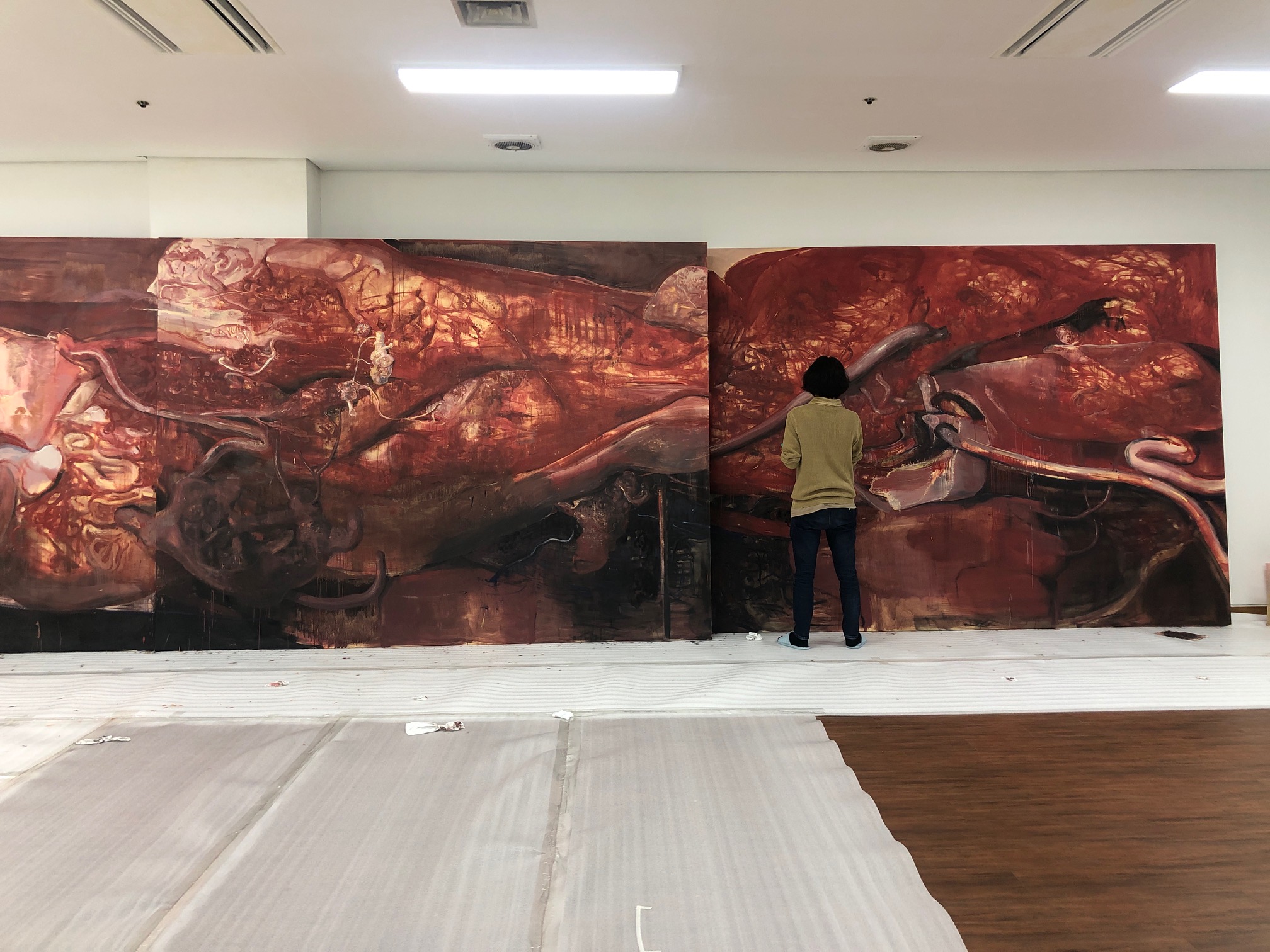
Where Things Happen #7 — Sept 2022
This month we take you out of the US, to discover a little bit of the emerging artists in the Seoul vibrant and fast-growing art scene, following our visits during last Frieze Seoul.
The art of Seoul-based painter Keunmin Lee is deeply visceral, existing at the very fine line between hallucination, obsession, and bodily reality of suffering.
From the large canvases to more medium sizes, the art of Keunmin does not admit any influence from the outside: all the colors and the tormented forms come directly from the abysses of the inner world and the depths of psyches, as elaboration and catarshis of the hallucinations the artist has been subjected in some of the darkest moments of his life.
Keumin Lee was diagnosed with severe mental disease some years ago, but as he emerged from the darkest period, he has been able to turn his condition and all this suffering as a resource of uniquely visionary and highly original creative power.
When I arrive with an uber – by that time, I had already learned the trick of just tapping the address in korean to have it working – Keunmin Lee comes to get me and walks me to his studio, located inside a store/storage building in a quite central area of Seoul.
All around us, warm red, brown and dark tainted canvases create an ocean of voracious sensations that instinctively touch something deeper, beyond the surface not only of the canvas but also of the bodies and reality, already inside the subconscious.
Despite the initial linguistic challenges, we are able to discuss his work, sometimes using the google translator as help but getting anyway into a very deep conversation.
As Keunmin Lee would explain, all these paintings are the result of an attempt to instinctively trace, sign and translate the inner world, with its desires, obsession, fears and sufferings but beyond all bounds of sensibility. Defying any material references and any narrations, his works could be described as hallucinatory mindscapes, characterized by a timeless and happenless of suspended ghosts and traumas that are still haunting the subconscious abysses.
There’s indeed a lot of suffering in Keunmin.
I can perfectly obsrve how some works are more abstract than others, getting closer to a fiercely expressionist abstraction of fragmented signs and entangled masses of colors.
In others works, instead, you can still read some hideous figures: as he explains, his style of the paintings change freely, reacting and adapting to the artist’ psychological condition and byorythm.
In this overwhelming red surface there are scars, exploding pain, but also enigmatic eyes of memory specters that are still haunting on the nights and on the mind.
In this sense, the art of Keumin Lee is probably one of the most genuine in the panorama today, comparable to the one by outsider artists, as well as great masters such as Francis Bacon, Leon Golub, Philip Guston.
Today Keunmin Lee is doing much better, and art has somehow become his remedy from paranoia: a way to translate and try to decipher irrational sensations and visions, to translate this suffering into something aesthetically powerful, but even before that, extremely therapeutic. In fact, as the artist confesses, painting is for him a need, a healing toll of catharsis in his fight against those spectures.
This is made quite clear also by the series of drawings that he will later show me: brutally intricated bodies in metamorphosis are seemingly obsessively detailed in their parts, while twisting and belding on themselves or abnormally growing in their parts and protuberances as contaminated by some weird infection or parasite. The infection and the parasite is inside the psyche, and overflows into the body.
The work of the artist forces us to confront also with the difficulty in describing, examining coping with mental health issues adequately as it’s something that escapes any science and pure medicine, and has to do with the depth of oneself. At the same time, his works allow us to understand the creative potential that these special mental conditions often allow, enabling us to withstand all the usual filters of expression the society would impose on us.
As we talk, in my head I start associating Keunmin work with the idea of “sublime” as expressed by Edmund Burke and by the best of English Romanticism: a strong and intense experience of awe, terror and danger all in one, caused by spectacular but also threatening phenomena where beauty and terrror and inevitably entangled, capturing the soul in an extremely strong aesthetic experience.
Despite in Lee’ case this state of mind is completely detached from nature, his process of creation is similarly triggered by that special moment when the subjective-internal (emotional) is forced to encounter the objective-external, and this dialectic conflict and subsequent collapse, finally allows our emotions to overwhelm our rationality and experience the wonder of pure creation.
Despite the artist has been operating kind of under radar in the past years, after his recent solo exhibition at Space K seoul and with International galleries descending to the South-Korea capital, it didn’t take long for him to be noticed: later this year he’s going to have a duo exhibition with Lehamaun Maupin in Seoul.
He doesn’t seem worried about, or particularly excited: He will just see what the world will bring him. For him art is first and foremost a need, a therapeutic tool for him, but also for society, to deepen the awareness of the potential and threats of a too often ignored inner world.












































